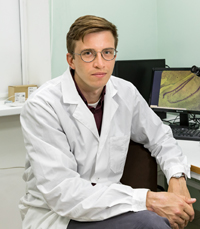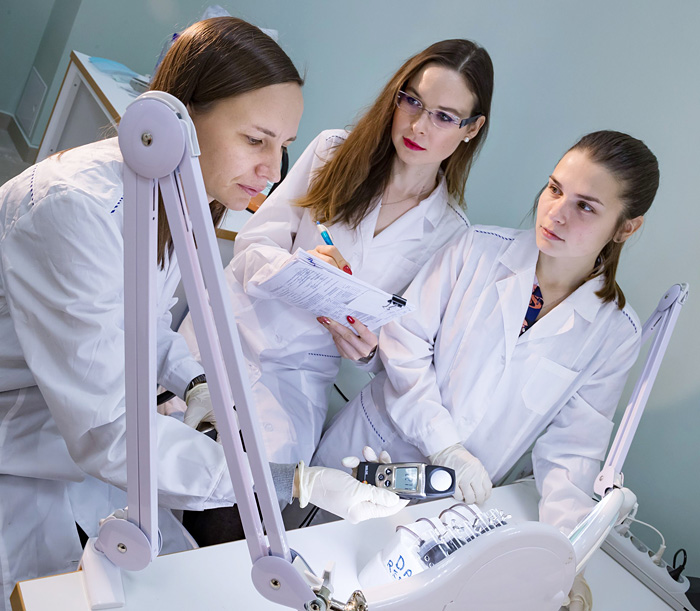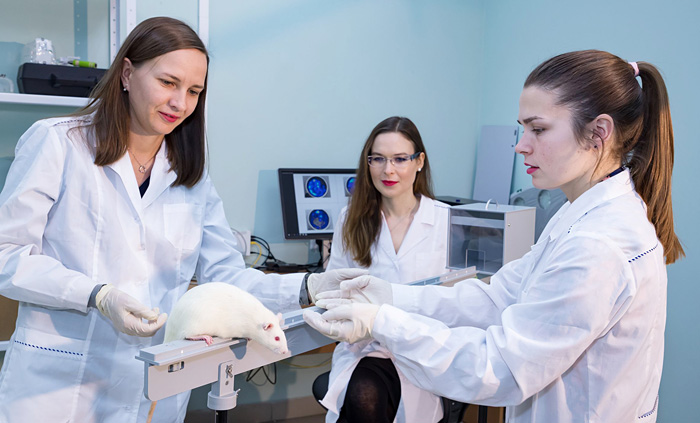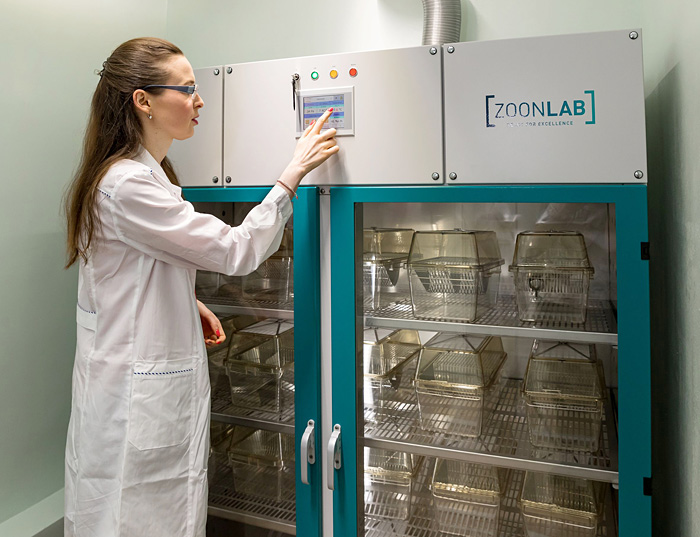New tasks in a new building
News, 10 June 2019
At the beginning of June, a vivarium will start its operation in the LRB Sector of Radiation Physiology. Small laboratory animals necessary for experiments will be kept in it. The Sector has recently moved to building #71 at the DLNP site, just as the Sector of Astrophysics that has been also placed in the same building. Researcher of the Sector Yuri S. Severuikhin guided a tour around all the premises of the Sector.
 “We moved here two years ago, and we got several rooms here. We were waiting for it to carry out our radiation and physiological experiments to the full extent. In one of the rooms, the “dark room”, we study degenerative changes in the visual system (the retina, the lens, and other elements of the visual system) after the impact of charged particles of various energies. This work is conducted under the supervision of Mikhail A. Ostrovsky in collaboration with MSU and the RAS Institute of Biochemical Physics. A separate room is equipped for studies of behavioural reactions of small laboratory animals. We have an extensive choice of facilities: for the study of long-term memory, short-term memory, physical activities, emotional status, research activities, motor defects. Creation of a project of this laboratory facility and placement of all necessary equipment were carried out by a special Moscow organization. Nowadays, we have video equipment and a special software package for the analysis of behavioural reactions. We can conduct not only research on direct radiation impact but also experiments on the study of pharmaceutical correction of this impact. It is possible to study nootropics, neuroprotective substances here.
“We moved here two years ago, and we got several rooms here. We were waiting for it to carry out our radiation and physiological experiments to the full extent. In one of the rooms, the “dark room”, we study degenerative changes in the visual system (the retina, the lens, and other elements of the visual system) after the impact of charged particles of various energies. This work is conducted under the supervision of Mikhail A. Ostrovsky in collaboration with MSU and the RAS Institute of Biochemical Physics. A separate room is equipped for studies of behavioural reactions of small laboratory animals. We have an extensive choice of facilities: for the study of long-term memory, short-term memory, physical activities, emotional status, research activities, motor defects. Creation of a project of this laboratory facility and placement of all necessary equipment were carried out by a special Moscow organization. Nowadays, we have video equipment and a special software package for the analysis of behavioural reactions. We can conduct not only research on direct radiation impact but also experiments on the study of pharmaceutical correction of this impact. It is possible to study nootropics, neuroprotective substances here.
In another block of laboratory rooms, we study morphological changes in brains of experimental animals. Due to the widened range of our tasks on issues of radiation medicine, we carry out research on morphological and functional changes in various tissues and organs under radiation. We have all necessary equipment for it. A separate block and special equipment are allocated for animal housing. A vivarium (in the photo) is equipped with modern computerized devices regulating and recording conditions of the animal’s housing. Dozens of rats and two hundred mice can be kept simultaneously in it. We have necessary rooms for experiments in which sterilization of needed materials will be carried out.”
“Will you keep laboratory animals here constantly or only during experiments?”
“At first, we discuss the plan of the experiment, estimate the necessary amount of animals, and discuss all stages of the experiment with colleagues. A special breeding garden in Pushchino supplies animals to us. We order particular animals for particular experiments. For example, we rarely use albino mice for research on retinal pigment epithelium. We use animals of other special lines for this aim. Behavioural tests are carried out at rats as far as they have more complicated, interesting behaviour in comparison to mice. A specialist-zootechnician look after animals; six young researchers work in the Sector. At large, they are graduates of the Biophysics Department of the Dubna University. A colleague from Slovakia Maria Lalkovičová has been working with us for 2 years. She is a specialist in the fields of neurodegeneration. Jointly with Maria, we introduce new techniques into research in the fields of neurodegeneration in tissues of the brain.”
 Preparation to the experiment on the study of radiation-induced defects in the visual system is conducted by D. M. Utina, M. G. Lalkovicova, K. N. Lyakhova
Preparation to the experiment on the study of radiation-induced defects in the visual system is conducted by D. M. Utina, M. G. Lalkovicova, K. N. Lyakhova
“Before moving to this building, major experiments were carried out in a building of the Institute of Medical and Biological Problems. I prepared my thesis under the supervision of Prof. Alexander A. Ivanov, Leading Researcher of our Sector. At the present stage, our Sector is actively developing; we are thankful for the support provided by the LRB Directorate. I think it is excellent that in the Institute there are fascinating applied research fields that are closely connected with significant health and safety problems of all mankind. I believe that is of crucial importance. Recently, more and more attention is paid to radiation pharmaceutics, particularly to study of medications, substances that in this or that way can modify the radiation effect. For example, the latest work by Evgeny A. Krasavin carried out jointly with colleagues was dedicated to the study of medications able to increase radiation effects under the impact of gamma-quants, a medical proton beam. It can significantly increase the effectiveness of radiotherapy. We also take an active part in research on the impact of such medications.”
 Conducting the experiment on the study of motor deficit of rats at the Beam Walking facility
Conducting the experiment on the study of motor deficit of rats at the Beam Walking facility
“Do you use primates in your work?”
“No, we don’t. We get primates from other institutes. We put much of the attention to research on rodents, animals at which in vivo experiments are conducted all over the world. The interest in this research increases. I have even noticed that more and more reports at conferences and seminars are made on related disciplines. Moreover, the number of publications in Russian and abroad also increases. We may say that Dubna is Eldorado for radiobiologists as far as there is an opportunity to use experimental facilities. Specialists from numerous Moscow institutes, such as MSU, IBMP, Burnasyan Federal Medical Biophysical Centre, come to us for carrying out experiments to study radioprotective properties of the antioxidant – superoxide dismutase. Results of their research were published.”
“Do you participate in UC educational practices? Do you attract the youth from the JINR Member States?”
“Yes, many students join us. A new building gave us an opportunity to hold lectures and seminars in the conference hall. We introduce to students our research as well as demonstrate facilities and equipment to them. We held two summer practices for students in the frames of the UC programme; a student from the Czech Republic and three students from the RSA worked with us. Our studies greatly interested them. As a rule, coming students are physicists, chemists, and programmers. That is why they are interested to have practice in biological fields. It is a new world.”
Olga Tarantina, JINR Weekly Newspaper
Photos by Elena Puzynina
